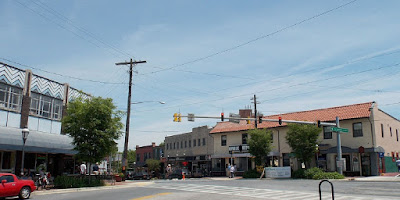Victorian Architecture B&O Railroad Parks Neighborhoods Education and Diversity
Takoma Park what is now Takoma Park MD and Takoma D.C. began as
a late 19th century railroad stop Victorian suburb known only as
Takoma Park. Founded in 1883 and incorporated in 1890. It is a planned commuter
suburb located along the Metropolitan Branch of the historic B&O Railroad
northeast of Washington, D.C.
History Takoma Park as one
of first railroad-accessible suburbs in the D.C. area. At 350 feet in
elevation, this new suburb was high enough to avoid the malaria and mosquitoes
that plagued the nation’s capital.
Until 1997, the City straddled two counties with the eastern portion of
Takoma Park located in Prince George’s County and the western portion in
Montgomery County.
Preserving Historic Takoma Park among
the first suburbs of Washington D.C., Takoma Park is the largest historic
district in Montgomery County. The Montgomery
County Historic District was established in 1992, with Takoma Park its largest
district in the County; it includes several residential and commercial
neighborhoods such as Takoma Old Town and Takoma Junction. Takoma DC is also an
historic district, making the area one of the only multi-jurisdictional historic
districts in the region.
Residential and Commercial
property owners in the Montgomery County Takoma Park Historic District require
a Historic Area Work Permit prior to
undertaking any proposed changes to the exterior of a structure or to the
environmental setting of their site.
First American
City to Allow Municipal Vote to 16-Year-Old Citizens
The National Register of
Historic Places District for Takoma Park was designated in 1976 in Maryland
and in the District of Columbia in 1983. Much of the original residential
development was included in this district, which embodies a rich variety of
American architectural late 19th to early 20th century
styles.
Stream Valley Parks along
Sligo Creek and Long Branch Creek cross the city and, along with other city parks,
provide bike trails and play areas for the community.
Diversity Takoma Park is a
community of many different cultures and interests. There is no one racial or
ethnic category that represents a majority of the population. Over a quarter of
the population was born in another country, mostly from Latin America and
Africa. Residents can walk, bike, or take a short Metro or bus ride to many
popular destinations.
US
Main Streets and Historic Districts Itineraries
Travel
itineraries based on client interests by leveraging an in-depth
knowledge of your destination, superior client service in the planning stages
and throughout the trip or event and logistics expertise to reduce accommodations
and transport costs as well as transfer times.
Neighborhoods Takoma Park is
largely residential, with a mix of single family homes and small and large
apartment buildings. Homes range from historic bungalows and Victorians to
modest colonials and ramblers. The largest commercial district is
Takoma-Langley Crossroads, centered at the intersection of University Boulevard
and New Hampshire Avenue. The Old Takoma business area is a neighborhood
commercial district near the Takoma Metro station.
Education the Takoma
Park/Silver Spring campus of Montgomery College (a community college) and the
campus of Washington Adventist University are in Takoma Park. Besides the
excellent Montgomery County public schools, Takoma Park is served by several
private parochial schools.






